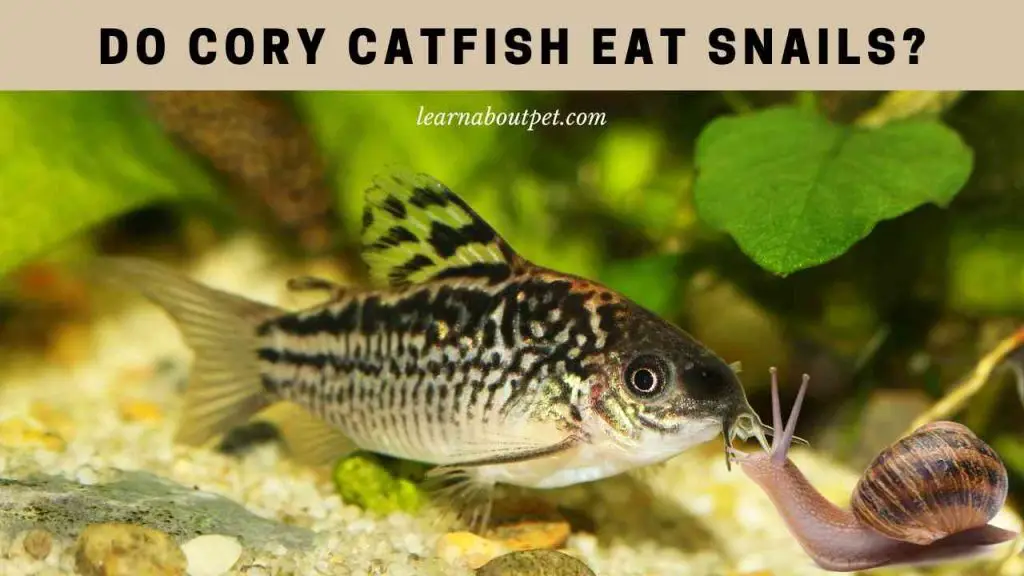Are you considering introducing snails into a tank with cory catfish (or vice versa)? Or do you have a pest snail problem in a tank, and wondering whether cory catfish can help you to reduce the snail numbers? In such situations, you are likely to be keen on knowing whether cory catfish eat snails. Read on, for answers.
Do cory catfish eat snails? Most cory catfish don’t eat live snails, but a few do. Those that do only eat the tinier snails. All cory catfish can, however, eat dead and crushed snails.
The bigger snails that most people keep as pets are too big and hardy for cory catfish to kill and eat. Therefore you can safely keep cory catfish with such pet snails in a tank.

The cory catfish may, however, feed on snail eggs when they happen to come across them.
Can Cory Catfish Eat Snails?
Before proceeding to answer the do cory catfish eat snails question, we first need to find out whether these fish have the ability to eat snails.
Snails typically have hard shells. These shells often prove hard for most cory catfish to break open. This is why only a few cory catfish seem to have the ability to eat snails.
Moreover, many snail species are too big for cory catfish to kill and eat. This is why even the few cory catfish that eat live snails limit themselves to the tinier ones.
So, in yes or no terms, do cory cats eat snails? The answer is ‘yes’ – some few cory catfish seem to have the ability to eat (the tiny) snails.
Most cory catfish, however, are unable to break the tough shells on snails. And many snails are too big anyway to be killed and eaten by cory catfish.
All this, of course, is with respect to live snails. When it comes to dead (and crushed) snails, the story is different.
Do cory catfish eat snails that are dead and crushed? The answer, in this case, is a categorical yes.
Remember, what normally keeps the cory catfish from eating snails are the tough shells on the snails, as well as the snails’ sheer sizes.
Now once the snails are killed and crushed, these hindrances are no longer. The catfish then get to devour them heartily.
Cory catfish may also eat baby snails, whose shells are yet to toughen too much, and whose sizes are not yet too intimidating.
All in all, you will often find the cory catfish in most lists of freshwater fish that eat snails. Therefore the phenomenon of corys eating snails is not entirely out of the ordinary.
How Do Cory Catfish Eat Snails?
The snail eating process (for the few cory catfish that eat live snails) typically has three key steps.
The first step is where the cory catfish locate the snails. This they normally do in the course of their routine scavenging. They then size up the snails, to see whether they are of a size they can kill and eat.
The second step is where the cory catfish dig the snails out of their hiding spots. (Yes, cory catfish can dig, with their mouths).
Normally, snails hide in the substrate under water. Cory catfish are able to dig into the substrate, to get the snails out.
The third step is where the cory catfish break the snail’s shells, in order to access the actual snail meat. This often proves to be the most challenging part of the whole endeavor.
Note, however, that not all cory catfish will be able to eat snails in this way.
For instance, if you try to research on the will Julii cory catfish eat snails question, you will see that most of the Julii cory catfish are unable to eat snails.
Nonetheless, the 3 step process described above is with respect to cory catfish killing and eating snails.
But there is also the scheme where cory catfish eat snails that have already been killed and crushed.
In this case, the process of cory catfish eating the snails simply entails sucking at the meat (from the crushed shell). It is something that pretty much all cory catfish will relish.
When Do Cory Catfish Eat Snails?
It has been posited that cory catfish will typically only resort to eating snails when they are almost starving.
But once the cory catfish get a taste of the snails under such circumstances, they are likely to thereafter start killing and eating them whenever they can. That includes even when they are well fed.
Here is another answer to the when do cory catfish eat snails question: when the snails are killed and crushed for them.
When the snails are killed and crushed, almost all cory catfish will happily munch on them.
Which Types Of Cory Catfish Eat Snails?
Where it is a matter of finding live snails, killing them and eating them, only the bigger cory catfish will attempt it.
So, for instance, the bandit cory catfish may be able to kill and eat snails. So may the bronze cory and pepper cory.
But smaller ones, like pygmy cory and skunk cory may be unable to tackle adult, hardy snails.
At this point, one may ask, do albino cory catfish eat snails? And the answer is that the albino cory catfish may sometimes be able to kill and eat snails. That is because it is one of the bigger cory catfish types.
But whether or not an albino cory catfish eats snails is also a matter of personal preference.
So this question – on eating snails – is not as straightforward as the do albino cory catfish lay eggs question.
Neither is it as simple as the one on how to tell if a albino cory catfish is male or female.
You may have an albino cory catfish that is big and strong enough to kill and eat a snail. Yet, as a matter of personal preference, it doesn’t – especially if there is other food around.
Which Types Of Snails Do Cory Catfish Eat?
Where it is a matter of actually killing and eating the snails, cory catfish can only eat the tinier snails. So those are snails that are small in size, and with softer shells.
This means that baby snails are particularly susceptible to cory catfish predation. That is because they are small, and their shells are not yet fully hard.
Of course, where it is a matter of eating snails that have been killed and crushed by humans, then cory catfish will eat almost all types of snails in that case.

Do Cory Catfish Eat Assassin Snails?
Assassin snails are among those that are too big in size (and those whose shells are too hard) for cory catfish to eat.
Remember, while answering the do cory catfish eat snails question, we said that the cory catfish can only eat the smaller snails with softer shells.
But if a cory catfish that is particularly hungry happens to chance upon a small baby assassin snail, then it may (try to) eat it.
And if an assassin snail is killed and crushed, the cory catfish will happily suck on its meat.
Do Cory Catfish Eat Trumpet Snails?
The only trumpet snails that cory catfish may be able to kill and eat are young ones.
Adult trumpet snails are typically too big and hardy for cory catfish to eat.
But cory catfish may eat a trumpet snail if it finds it already dead and crushed.
Do Cory Catfish Eat Bladder Snails?
Whereas bladder snails are modest in size, they nonetheless usually have very hard shells. On that account, cory catfish may be unable to eat them.
But cory catfish may eat bladder snail babies and eggs.
And if a bladder snail is killed and crushed, a cory catfish will eat it with ease.
Do Cory Catfish Eat Pest Snails?
Most of the people who pose the do cory catfish eat snails question turn out to be individuals with pest snail problems. So they wonder whether the cory catfish can help them in controlling the pest snails.
Whether or not cory catfish are able to eat pest snails depends on the size and nature of the snails.
If they are small and with softer shells, the cory catfish may eat them.
But if they are big and hardy, the cory catfish may be unable to eat them.
Even where the cory catfish are able to eat the pest snails, they are unlikely to do so in significant numbers.
So it is best to use other more efficient pest snail control measures.
Will Cory Catfish Eat Baby Snails?
Baby snails are typically of a size that is small enough for cory catfish to kill and eat. Moreover, their shells may not be too hard.
Therefore cory catfish can eat baby snails, if they happen to come across them.
Do Cory Catfish Eat Snails Eggs?
Eating live snails and eating snail eggs are entirely different affairs. This leads to the question: will corys eat snails eggs?
This is really a natural extension to the do cory catfish eat snails question.
Now cory catfish do eat snails eggs, when they happen to find them.
While scavenging, cory catfish do sometimes come across snail eggs – which they may then proceed to eat.
Can Cory Catfish Live With Snails?
Here, we need to first start by finding out, do snails and cory catfish get along?
And the answer is mostly yes. Cory catfish are highly peaceful creatures. Therefore they can get along with snails and other tank mates.
We have seen many people keeping cory catfish and snails successfully. So it is doable.
One may ask, at this point, do cory catfish eat snails and shrimp (which would make them incompatible tank mates)?
And the answer – as we saw while answering the do cory catfish eat snails question – is that they typically don’t eat live snails (and shrimp for that matter).
They may, on occasion, eat a baby snail (or a baby shrimp, as may be the case).
But for the most part, the cory catfish are usually able to coexist with snails. That is especially the case for the bigger types of snails that we normally keep as pets.
Final Verdict – Do Cory Catfish Eat Snails
It is not very common for cory catfish to eat live snails. Many snails have shells that are too hard for the cory catfish to crack open. And many snails are simply too big for cory catfish to kill and eat.

But where snails are killed and crushed, cory catfish will easily and happily suck on their meat.
All in all, in most cases, it is possible to keep cory catfish and snails together in one tank.
As a pet lover, make sure to learn about pet more and give your pet fish a good and comfortable life!

Welcome to Learn About Pet. My name is Rajkumar Ravichandran and I love all pets, travel, and amazing food. I write about my passion and personal experience caring for multiple pets in this blog! ❤️
Post Disclaimer
DISCLAIMER: THIS BLOG OR WEBSITE, "Learn About Pet", DOES NOT PROVIDE YOU WITH MEDICAL ADVICE AND IS NOT A SUBSTITUTE FOR MEDICAL ADVICE. ALWAYS GET IN TOUCH WITH YOUR PERSONAL VETERINARIAN AND USE INFORMATION HERE AS GENERAL ADVICE.
The information, including but not limited to, text, graphics, images and other material contained on this website are for informational purposes only. No material on this site is intended to be a substitute for professional veterinary advice, food recommendation, diagnosis, or treatment. Always seek the advice of your veterinarian or other qualified health care provider with any questions you may have regarding a medical condition or for pet food related questions.







